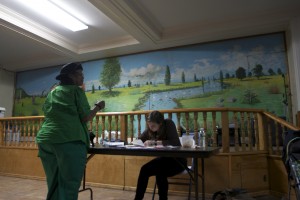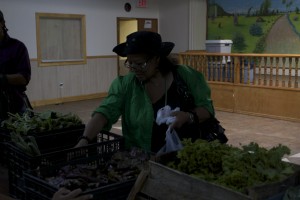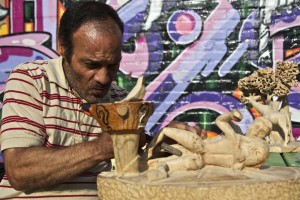Nearly 40 people gathered Tuesday, Oct. 3 in a church on the Grand Concourse over a bounty that included arroz con gandules, pico de gallo, green plantains with cheese and three types of tacos. The meal was notable not for its Latino roots, but for its use of fresh, pesticide-free vegetables in an area of the South Bronx where it’s often hard to find healthy food.
The diners were all members of the Farm Fresh Project, a group of 50 Bronx residents who have signed up to receive weekly supplies of produce from an upstate farm. But the project has reached its membership limit so now organizers are hoping to spread the healthy eating message in other ways, such as the potluck supper, which was made by members using their recent supply of produce.
“It’s a way to build community,” said Jackie Goulet, an Americorps member who coordinates Bronx CSA, a farm project for the New York City Coalition Against Hunger. “It’s a way to learn about new ideas and good recipes.”
The project is the first of its kind in the South Bronx and is a small step toward addressing a perennial problem in the neighborhood, which faces both a lack of fresh food supply and an obesity problem. Nearby Highbridge has only two supermarkets to serve 34,000 people, causing many local residents to shop at bodegas, most of which have meager and expensive produce offerings, according to Healthy Highbridge Coordinator Juan Rios. According to a 2008 city study called “New York City Neighborhood Grocery Store and Supermarket Shortage,” most of the districts in the South Bronx have too few places to buy fresh food. At the same time, a 2006 New York City Department of Health and Hygiene report shows four in 10 children and two out of three adults in the South Bronx are overweight or obese.
Community supported agriculture projects bring together a group of people who pay in advance for a season’s worth of goods from a nearby farm. This particular program offers food from Fresh Radish Farm, located 60 miles away in Goshen, NY. Area residents pick up vegetables, such as zucchini, onions, potatoes, tomatoes and greens weekly or biweekly. Whatever is left over is donated to the food pantry at Seventh Day Adventist Church at which the market is located.
Unlike traditional farm shares, this one is subsidized by a one-time $30,000 Legacy Project Grant from the Bronx Health Reach, a community-based healthcare initiative. Residents must sign a contract ahead of time, but can pay each week with a sliding scale based on income. A family making over $50,000 would pay $485, but a family on food stamps pays only $120 for the whole season, which lasts from June to November.
A bag of assorted produce estimated to feed a family of four costs $5.45 a week for families who receive food stamps.

Americorps worker and food share organizer Jackie Goulet says most of the farm share members pay in food stamps.(Rani Molla/THE BRONX INK)
An overwhelming majority of Bronx farm share members gets food stamps, Goulet said. Food stamp eligibility involves a number of factors, such as family size and income, but generally a family cannot have more than $2,000 in resources, according to the government’s food stamp fact sheet.
Concourse resident Maria Hernandez, 28, heard about the market from a friend. She said that since the farm share began, she’s been able to afford to make her young daughter more vegetable dishes.
“If you have them, you see what you can do with them,” she said of the vegetables, which she pays for with her food stamp card. “If you have to buy them, you can think of something else to make”—something else quicker and without produce.
Most of the members are also Spanish speakers, so Goulet canvassed since winter distributing pamphlets in both English and Spanish.
“It took a really long time to get 50 people to sign up,” the 24-year-old said. “It’s a weird concept people haven’t heard of: asking people for money for something they haven’t even seen yet.”
Goulet writes a newsletter each week that includes nutrition facts, information about the farm, as well as “quick, easy and affordable” recipes geared at the produce—necessary as new products are introduced to the population.
One recipe, “Grilled Cheese with a Twist,” suggests adding red onion, garlic, spinach and tomato to the quick staple. “Chunky Vegetable Soup” addresses the changing offerings of a farm share by suggesting “soft vegetables like zucchini, green beans, summer squash, or leafy greens such as kale, spinach or collard greens.”
As a handful of people arrived before the 5 p.m. weekly market start time, Goulet told some perplexed produce shoppers they could use the strange and soft pumpkin greens for soup. The farm share also offers more recognizable produce, such as tomatoes, potatoes and lettuce.
Eva Sanchez, 33, a mother of three whose young son would occasionally help translate for her, enjoys the offerings.
“It’s economical and the vegetables are good,” she said. Sanchez, who lives on the Grand Concourse, prefers vegetables to meat but said choosing produce was harder before the farm share came to her neighborhood.
“It’s not difficult; it’s expensive,” said Sanchez, who heard about the project from a friend.
Sanchez also volunteers at the farm share, helping other people with their groceries. This is a step in the right direction, according to Goulet, who said normally farm shares are run by their members.
“It’s starting to take off on its own,” said Goulet, who commutes from her family’s home in Long Island. “That’s something I hoped would happen.”
Goulet ends her Americorps work in December but says she believes the project will go forward, adding that next year the farm share could carry fruit in addition to vegetables. This year a scheduling conflict prohibited the small organization from receiving fruit deliveries.
According to New York City Coalition Against Hunger spokeswoman Theresa Hassler, “It’s the first year, so of course we plan on growing. We definitely plan on expanding and growing in coming years as participation and interest grow.”
With that, farm share employees hope the community will grow healthier too.













